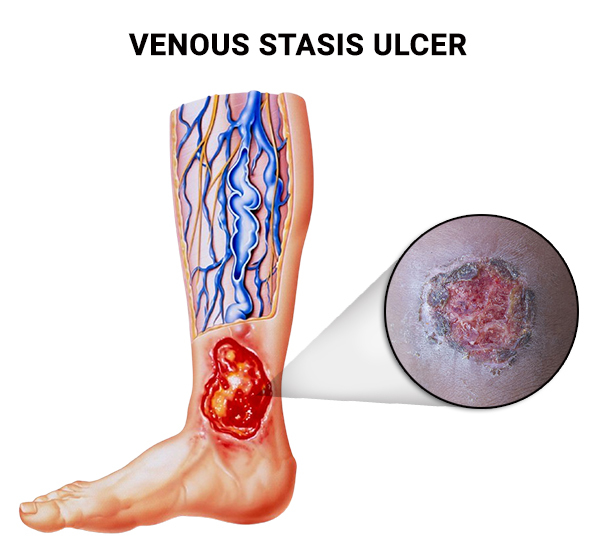

Open wounds on the legs are difficult to heal properly and can be unsightly. They are painful and may indicate deeper problems with the circulatory system. Call today to schedule an appointment with an experienced vein doctor at the Vein Care Center in New York City – Upper East Side, Midtown Manhattan and Greenwich Village, and the Financial District. In New Jersey, contact the vein specialists in Englewood Cliffs, Cranford, East Brunswick, Paramus, and Riverdale.
A venous stasis ulcer is an open wound due to a malfunction in the valves within a vein, leading to increased pressure in the veins. This can cause the vein to leak. The ulcers mostly occur on the lower legs and often take a considerable amount of time to heal, sometimes extending for weeks, months or longer. The ulcers can be painful, affecting mobility and quality of life.
Veins carry deoxygenated blood back to the heart from body tissues and organs. To aid in the flow of blood, veins have valves that prevent the backflow of deoxygenated blood. A failed valve hinders blood circulation, leading to pooling and increased blood pressure in the veins.
At the center for vein restoration in New York City and New Jersey, the best-rated vein specialists, led by Dr. Jonathan Arad, diagnose and treat a wide range of venous conditions. Using individualized treatment plans, the team relies on advanced medical techniques in venous ulcer treatment and other conditions affecting your veins.

In healthy veins, blood flows back properly through the contraction of muscles and the opening of valves. Any structural changes in the veins affect such flow and can lead to blood pooling and increased pressure. The increase in pressure then causes an open sore, called an ulcer, which usually doesn’t heal quickly.
Venous ulcers form for a variety of reasons, including:
Dr. Jonathan Arad is a graduate of Cornell University, Columbia University and the Medical School of International Health. He’s also a leader in the treatment of vein disease, as he provides the best venous skin ulcer treatment while addressing the underlying causes.
Some factors make you more vulnerable to venous stasis ulcers. As part of your interventional venous skin ulcer treatment, your doctor discusses these factors during your initial vein consultation to help you prevent a recurrence of the problem.
Risk factors for developing a venous ulcer include:
The vein specialists at the Vein Care Center provide excellent care at their multiple locations in New York City and NJ – Bergen County, Morris County and Union County. Treatment starts after your doctor reaches a diagnosis using the latest medical equipment.
Common symptoms of a venous stasis ulcer include:
If you have these symptoms, the vein doctors at the Vein Care Center led by Dr. Arad can help. With a personalized, integral approach to vein treatment, the team achieves high success in venous stasis ulcer treatment.
"The staff is friendly and very helpful. It’s an awesome place. I like to ask questions and the Doctor was very happy to help and answer all my questions in a very informative way.
For the most effective venous stasis ulcer treatment, your doctor considers your symptoms and carries out further diagnostic tests to identify the underlying cause of the vein problem before treatment starts. Your doctor then chooses the venous skin ulcer treatment based on the severity of your condition, the level of infection in the ulcer, your age and any other underlying conditions.
Effective treatment options include:
Your vein specialists at the Vein Care Center not only provide the best diagnosis and venous skin ulcer treatment, but also advise on preventive care. Some lifestyle changes — such as exercising, healthy eating, and quitting smoking — can help with your venous ulcer. Contact the vein doctors at the Vein Care Center to get the help you need with any vein problems.